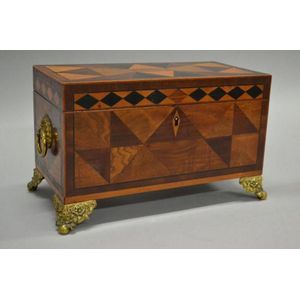French Walnut Marquetry Commode with Marble Top
You must be a subscriber, and be logged in to view price and dealer details.
Subscribe Now to view actual auction price for this item
When you subscribe, you have the option of setting the currency in which to display prices to $Au, $US, $NZ or Stg.
- Ormolu - Ormolu was popular with French craftsmen in the 18th and 19th century for ornamental fittings for furniture, clocks and other decorative items. True ormolu is gilt bronze, that is bronze that has been coated with gold using a mercury amalgam. Due to the health risks associated with using mercury, this method of creating ormolu was discontinued in France in the 1830s. A substitute was developed consisting of about 75% copper and 25% zinc, however it was inferior to the bronze version. It was often lacquered to prevent it tarnishing.
- Commode - The word "commode" when used to describe an item of furniture, has three usuages:
1. As used to describe an item of English furniture, it refers to what is euphemistically called a 'night table', that is a small cabinet concealing a chamber pot.
2. In its 18th century French usuage it describes a low and highly decorated chest of drawers for salons and reception rooms. A bombe commode is a commode with rounded sides and front, giving the chest a somewhat swollen look.
3. It is also used to denote a half round or serpentine shaped cabinet, with panelled doors, standing on legs. They were pieces on which the cabinetmaker lavished his most accomplished art, with rich veneers, marquetry inlays, gilt mounts and other ornamentation. - Marquetry - In marquetry inlay, contrasting woods, and other materials such as ivory, shell and metal are inlaid either as panels or in a single continuous sheet over the surface of the piece. The design may be straightforward, such as a shell pattern or a basket of flowers, or it may be infinitely complex, with swirling tendrils of leaves, flowers and foliage, such as one finds, for example, in the "seaweed" patterns on longcase clocks of the William and Mary and Queen Anne periods.
This item has been included into following indexes:
Visually similar items

A Georgian oak mule chest, with two drawers in base and internal candle tray with two small drawers, ornately carved decoration, arched panels of floral designs and traditional motifs, brass bale handles and ogee bracket feet. 140 cm x 55 cm x 87 cm

Oak coffer, English, 17th century, front panel decorated with carved wheels and stars, metal lock, plank top. Height 65 cm. Width 116 cm. Depth 52 cm. Provenance: The Estate of a Lady, NSW

Antique French large size bench with lift up seat, the shaped and carved panelled back and sides, with carving low relief, approx. 128 cm high, 170 cm wide, 74 cm deep

Antique Georgian specimen wood parquetry tea caddy, fitted with two caddies and central glass, standing on repousse brass bracket feet, drop ring handles to the sides, approx16 cm high, 28 cm wide, 15 cm deep
